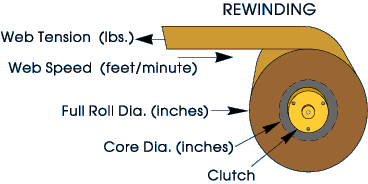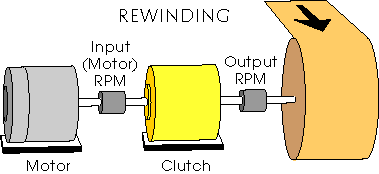

TORQUE - For load simulation, torque limiting and similar applications, torque is already known.
For web handling, torque must be calculated. First determine the desired tension in your web (wire, fabric, film etc.) Calculate the required torque :
TORQUE (lb.-in) = TENSION (lbs.) x ROLL DIA. (inches) x 0.5
Use the Full Roll Diameter for calculating the maximum torque needed
For applications with the web running over a pulley or between nip rollers (pinch rollers), use the pulley diameter as the roll diameter in the formula above.Always be conservative - select the next larger model if the application requires nearly the rated torque
RPM - RPM is used for slip (thermal) heat calculations. RPM must be less than the maximum allowable.
For load simulation, torque limiting and similar applications, RPM is already known.
For web handling, usually linear speed (Web Speed) is known, and RPM must be calculated. Calculate RPM :
RPM = 3.8 x WEB SPEED (feet per minute) / ROLL DIAMETER (inches)
Use the Full Roll Diameter to determine the slowest speed. Use the Core Diameter (empty spool diameter), to determine the fastest speed. For applications with the web running over a pulley or between nip rollers (pinch rollers), use the pulley diameter as the roll diameter.
For rewinding, motor RPM should be slightly higher (10 percent or 30-50 RPM higher) than the fastest spool RPM to avoid slack.

SLIP (Thermal) HEAT DISSIPATION - Slip torque produces heat. The model must be physically large enough to not overheat. Calculate heat input:
HEAT (watts) = TORQUE (lb. in.) x ( INPUT RPM - OUTPUT RPM ) x 0.012
To minimize heat input in clutch applications, clutch input RPM should only be about 30-40 RPM faster than the fastest required output RPM. Faster slip speeds generate higher heat and wear with no benefit.
DUTY CYCLE - The average heat input must be below the clutch's heat dissipation rating. If the motion is intermittent, use the average speed for thermal calculations.